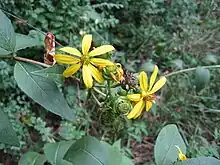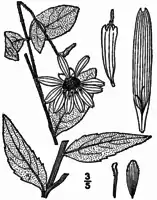| Silphium asteriscus | |
|---|---|
 | |
| Silphium asteriscus var. asteriscus | |
| Scientific classification | |
| Kingdom: | Plantae |
| Clade: | Tracheophytes |
| Clade: | Angiosperms |
| Clade: | Eudicots |
| Clade: | Asterids |
| Order: | Asterales |
| Family: | Asteraceae |
| Genus: | Silphium |
| Species: | S. asteriscus |
| Binomial name | |
| Silphium asteriscus | |
Silphium asteriscus, commonly called starry rosinweed,[2] is an herbaceous plant in the family Asteraceae. It is native to the eastern United States, from Oklahoma and Texas east to Florida and Pennsylvania.[3] It is a widespread species found in a variety of open habitats, such as prairies and woodlands.[4]
Taxonomy
Additional research is needed to better understand the taxonomy of this species. It remains perhaps the most poorly-understood Silphium in eastern North America.[5] It appears to show a high level of local variability throughout its range, which has been interpreted as either a species complex, a single highly variable species, or some combination of both. Due to conflicting information about the best circumscription of the varieties, the taxonomy of this species remains unsettled.[6][7]
The most recent treatment from 2020 ranked Silphium asperrimum, Silphium dentatum and Silphium simpsonii at species status.[7] If adopted, this leaves S. asteriscus with three remaining varieties. They are:
- Silphium asteriscus var. asteriscus - Appalachian and eastward; with a congested, hispid inflorescence
- Silphium asteriscus var. laitoflium - south and west of the Appalachians; with broad, opposite leaves and a spreading glabrous inflorescence
- Silphium asteriscus var. trifoliatum - widespread; similar to the above but with narrow whorled leaves[7]
 Line drawing of Silphium asteriscus
Line drawing of Silphium asteriscus
References
- ↑ "Silphium". Index Nominum Genericorum. International Association for Plant Taxonomy. 9 February 1996. Retrieved 24 June 2008.
- ↑ USDA, NRCS (n.d.). "Silphium asteriscus". The PLANTS Database (plants.usda.gov). Greensboro, North Carolina: National Plant Data Team. Retrieved 18 January 2017.
- ↑ "Silphium asteriscus". County-level distribution map from the North American Plant Atlas (NAPA). Biota of North America Program (BONAP). 2014. Retrieved 18 January 2017.
- ↑ Flora of North America
- ↑ Chester, Edward (2015). Guide to the Vascular Plants of Tennessee.
- ↑ Flora of Missouri
- 1 2 3 "Flora of the Southern and Mid-Atlantic States".
External links
 Media related to Silphium asteriscus at Wikimedia Commons
Media related to Silphium asteriscus at Wikimedia Commons Data related to Silphium asteriscus at Wikispecies
Data related to Silphium asteriscus at Wikispecies